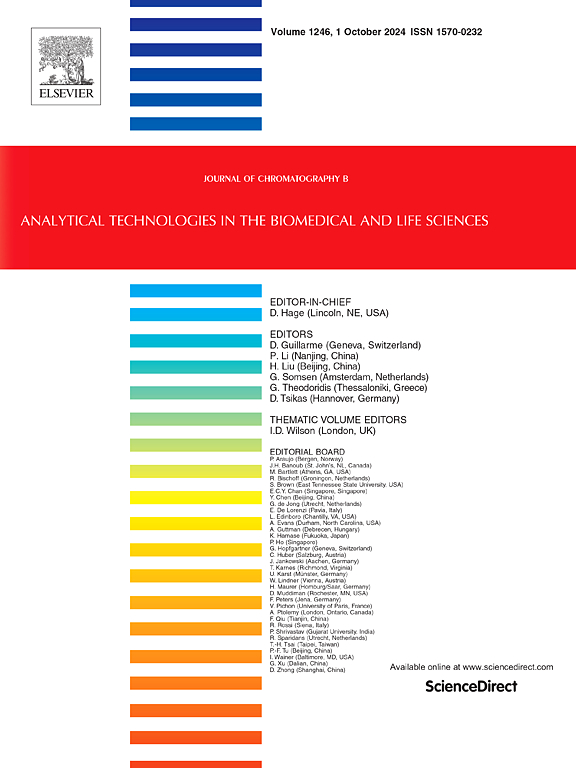一般人群合成玫瑰氧化物暴露的人体生物监测研究
IF 2.8
3区 医学
Q2 BIOCHEMICAL RESEARCH METHODS
引用次数: 0
摘要
玫瑰氧化物(RO)作为合成香料用于化妆品、卫生、洗衣、清洁和家用产品中。合成玫瑰氧化物不同于天然存在的玫瑰氧化物在其对映体组成。天然反渗透酶主要由(−)-顺式异构体组成,而合成反渗透酶含有大约等量的(−)-顺式和(+)-顺式异构体,以及少量的(−)-反式和(+)-反式异构体。由于在本项目中,通过人体生物监测(HBM)暴露于工业生产的化学品是重点,因此该方法的开发旨在从合成RO的(+)-顺式异构体中提取合适的尿液代谢物。为了鉴定合成反转录酶暴露的生物标志物并评估其毒性动力学,5名受试者被给予单次口服(0.1 mg/kg体重)和皮肤(0.5 mg/kg)剂量的合成反转录酶。利用Orbitrap仪器进行的高分辨率质谱分析(HRMS)显示,9-羟基-RO (9-OH-RO)、2-羟基-4-羧基-RO (HC-RO)、二羟基-RO和由环羟基化RO衍生的内酯是暴露于合成RO的潜在生物标志物。不幸的是,由于灵敏度不足(9-OH-RO)或无法获得所需对映体(HC-RO,二- oh - ro),内酯)的标准材料,试图开发和验证这些代谢物之一的HBM方法失败了。另外,开发并验证了顶空-固相微萃取-气相色谱-质谱(HS-SPME-GC-MS)方法测定母体化合物(+)-顺式ro。DVB(二乙烯基苯)/PDMS(聚二甲基硅氧烷)纤维最适合提取。对映体分离是在Lipodex G柱与温度梯度上实现的。在电子冲击电离(EI)模式下检测(+)-顺式ro。该方法定量下限为1 ng/L,精密度为10%,准确度为90%。口服后,(+)-顺式ro的尿排泄速度快(平均半衰期:4.1 h), 48 h后几乎完全排出。然而,5名受试者的平均尿排泄率仅为7 ppm。(+)-顺式ro在一般人群的14份尿液样本中约有一半达到或略高于最低限定值。总之,我们的研究首次提供了RO在人体内代谢和毒性动力学的数据。尽管性能良好,但新开发和验证的HS-SPME-GC-MS检测尿液中(+)-顺式反渗透的方法对于普通人群中暴露于合成反渗透的HBM仅具有有限的价值,因为未代谢的反渗透的尿液排泄率很小,并且在尿液收集和随后的分析步骤中存在被环境反渗透污染的潜在风险。对于合适的HBM方法,潜在的RO代谢物需要以对映体纯形式合成。我们的研究为这种方法提供了可能的候选者。本文章由计算机程序翻译,如有差异,请以英文原文为准。
Investigations on human biomonitoring for assessing the exposure to synthetic rose oxide in the general population
Rose oxide (RO) is used in cosmetic, hygiene, laundry, cleaning, and household products as a synthetic fragrance. Synthetic rose oxide differs from naturally occurring rose oxide in its enantiomer composition. While natural RO consists mainly of the (−)-cis isomer, synthetic RO contains approximately equal parts of (−)-cis and (+)-cis isomers, as well as small amounts of (−)-trans and (+)-trans isomers. Since in this project, the exposure to industrially produced chemicals by human biomonitoring (HBM) was in the focus, the method development aimed at suitable urinary metabolites derived from the (+)-cis isomer of synthetic RO. For the identification of biomarkers of exposure to synthetic RO as well as for assessing its toxicokinetics, 5 subjects were administered a single oral (0.1 mg/kg body weight) and dermal (0.5 mg/kg) dose of synthetic RO. Analysis of urine fractions by means of high-resolution mass spectrometry (HRMS, conducted with an Orbitrap instrument) revealed that 9-hydroxy-RO (9-OH-RO), 2-hydroxy-4-carboxy-RO (HC-RO), and di-hydroxy-RO and a lactone derived from ring-hydroxylated RO were potential biomarkers of exposure to synthetic RO. Unfortunately, attempts to develop and validate a HBM method for one of these metabolites failed due to insufficient sensitivity (9-OH-RO) or unavailability of standard materials for the required enantiomers (HC-RO, di-OH-RO), lactone). Alternatively, a headspace-solid-phase-micro-extraction-GC–MS (HS-SPME-GC–MS) method for the parent compound (+)-cis-RO was developed and validated. DVB (divinyl benzene)/PDMS (polydimethylsiloxane) fibers suited best for the extraction. Enantiomeric separation was achieved on a Lipodex G column with a temperature gradient. (+)-cis-RO was detected in electron impact ionization (EI) mode. The method performed well with a lower limit of quantification (LLOQ) of 1 ng/L, precision of <10 % and accuracy of >90 %. After oral application, urinary excretion of (+)-cis-RO was fast (mean half-life: 4.1 h) and almost complete after 48 h. However, the mean urinary excretion rate in the 5 subjects amounted to only 7 ppm. (+)-cis-RO was found to be at or slightly above the LLOQ in about half of 14 urine samples from the general population.
In conclusion, our investigations for the first time provide data for RO metabolism and toxicokinetics in humans. Despite good to excellent performance, the newly developed and validated HS-SPME-GC–MS method for (+)-cis-RO in urine is only of limited value for HBM of exposure to synthetic RO in the general population, due to the tiny urinary excretion rate of unmetabolized RO and the potential risk of contamination with environmental RO during urine collection and subsequent analytical steps. For a suitable HBM method, potential RO metabolites would need to be synthesized in enantiomerically pure form. Our study provides possible candidates for this approach.
求助全文
通过发布文献求助,成功后即可免费获取论文全文。
去求助
来源期刊

Journal of Chromatography B
医学-分析化学
CiteScore
5.60
自引率
3.30%
发文量
306
审稿时长
44 days
期刊介绍:
The Journal of Chromatography B publishes papers on developments in separation science relevant to biology and biomedical research including both fundamental advances and applications. Analytical techniques which may be considered include the various facets of chromatography, electrophoresis and related methods, affinity and immunoaffinity-based methodologies, hyphenated and other multi-dimensional techniques, and microanalytical approaches. The journal also considers articles reporting developments in sample preparation, detection techniques including mass spectrometry, and data handling and analysis.
Developments related to preparative separations for the isolation and purification of components of biological systems may be published, including chromatographic and electrophoretic methods, affinity separations, field flow fractionation and other preparative approaches.
Applications to the analysis of biological systems and samples will be considered when the analytical science contains a significant element of novelty, e.g. a new approach to the separation of a compound, novel combination of analytical techniques, or significantly improved analytical performance.
 求助内容:
求助内容: 应助结果提醒方式:
应助结果提醒方式:


